Total Biomass Carbon Sequestration Ability Under the Changing Climatic Condition by Paulownia tomentosa Steud
DOI:
https://doi.org/10.3126/ijasbt.v6i3.20772Abstract
The concentration of carbon dioxide (CO2) has risen continuously in atmosphere due to human induced activities, and has been considered the predominant cause of global climate change. Paulowina tomentosa Steud. (P. tomentosa), a multipurpose tree is popular around global market for its timber and its potential role in CO2 sequestration. In this study, the total biomass carbon of five years old and newly planted P. tomentosa has been estimated. The results indicated that the average total biomass carbon of five years old plant was found to be 4.52±0.53Kg C Year-1 per tree i.e. 9.04±1.06-ton C ha-1 Year-1 (assuming 2000 plants per hector). Likewise, the average total biomass carbon of newly planted P. tomentosa within 4 months was found to be 6.07±0.38 Kg in remote village area in Nepal. The estimated biomass carbon in one year of newly planted plants was found to be 18.21±1.14 Kg Year-1 i.e. 0.36-ton C ha-1 Year-1. These findings reveled that short rotational trees like P. tomentosa can be implemented in agroforestry system to reduce the green house emission in cities and emphasizes the carbon storage potential of agroforestry. In vitro micro propagation technique could be implemented to produce genetically uniform clone of P. tomentosa and can be applied in agroforestry system for the adaptation and to mitigate global climate change.
Int. J. Appl. Sci. Biotechnol. Vol 6(3): 220-226




